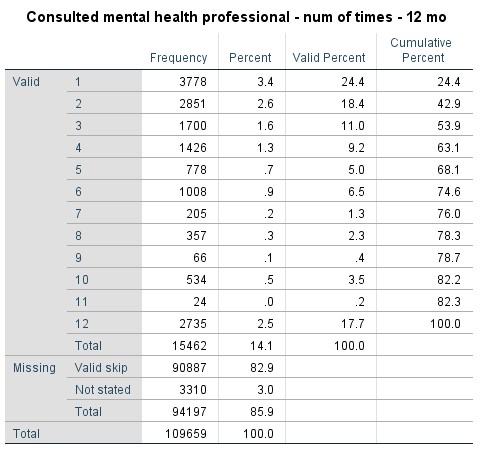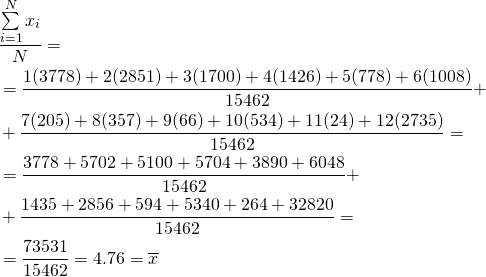Chapter 3 Measures of Central Tendency
3.5 The Mean With Existing Data and Other Considerations
Let’s work through some real-world data, this time from the Canadian Community Health Survey 2015-2016 (Statistics Canada 2017), a.k.a. CCHS 15/16, a very large dataset containing information on more than 100,000 respondents.
Table 3.6 Number of Times the Respondent Consulted a Mental Health
Professional in the Last 12 Months (CCHS 15/16)

To calculate how many times Canadians consulted a mental health professional in the last year preceding their participation in the survey based on the data above, we need to follow the principle we used in the age of classmates and number of siblings examples in the previous section.
Specifically, we need to multiply each value (1 through 12 number of times a mental health professional was seen) by its frequency, then to sum all the products together, and finally to divide the sum on the total number of respondents, 15,462 (recall that we only use valid cases for analysis and exclude the missing ones).

That is, we have found that the respondents on average consulted a mental health professional 4.76 times over the 12 months preceding the survey.
Do It! 3.4 How Many Times Has The Respondent Stopped Smoking for at Least 24 hrs In the Past 12 Months (CCHS 15/16)
To save you you from calculating into the thousands, here is a variable based on a question that 99.9 percent of the respondents did not have to answer, which gives you a manageable N=106. Calculate the average number of times respondents have stopped smoking for at least 24 hrs for the 12 months preceding the survey. While you’re at it, find and report the mode and median of this variable.
Table 3.7 Number of Times Respondent Stopped Smoking In the Past Year (CCHS 15/16)

I strongly encourage you to do the above exercise yourself. Still, as usual, here is an SPSS tip on how to obtain a mean in SPSS.
SPSS Tip 3.4 Obtaining the Mean
- From the Main Menu, select Analyze, then Descriptive Statistics, and then Frequencies;
- Select your variable of choice from the list on the left and use the arrow to move it to the right side of the window;
- Click on the Statistics button on the right;
- In this new window, check Mean in the Central Tendency section on your right;
- Click Continue, then OK.
- The Output window will provide a small table listing the selected variable’s mean.
